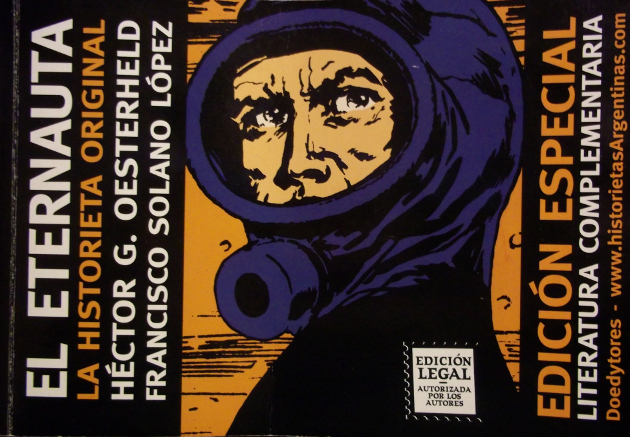The Eternauta
His grim visage is all over Buenos Aires. The Eternauta is the hero of one of the most influential science fiction comics ever published, and certainly the most important comic in Argentina’s history. He’s also the most often employed graffiti motif in the city.

I bought The Eternauta soon after we arrived in Buenos Aires. Originally published between 1957 and 1959 as a serial in the magazine Hora Cero Semanal, The Eternauta is a gripping 350-page account of humanity’s hopeless struggle against a superior invading alien force. Packed with action, drama, and rich in metaphor, it’s nearly impossible to put down. I read the whole thing in a matter of days.
The action unfolds in Buenos Aires as a strange snowfall suddenly descends upon the city. Juan Salvo, along with his friends and family, doesn’t need long to realize that something is horribly amiss. The snow flakes kill on contact, and the protagonists watch through the window in horror as the world dies: humans, animals, plants. Everything that comes in contact with even the smallest wisp of snow perishes.

It’s the opening attack of an unstoppable alien invasion. Once Juan and his friends develop hermetically-sealed suits that protect them from the snow and give them the appearance of astronauts, the story builds into an ever-crescendoing spiral of danger and despair, until finally reaching its incredible conclusion. Throughout it all, against an omnipotent opponent and impossible odds, Juan and his fellows never lose their courage or determination. Better to die like a man, fighting to the bitter end.
That powerful message was co-opted by former Argentine president Nestor Kirchner, when he implored his countrymen to “be like the Eternauta” in the face of their struggles. Before long, graffiti of Kirchner’s face in the Eternauta’s suit began appearing on the streets of Buenos Aires.

The Eternauta is a work rich in subtext and metaphore. The “Manos” are part of the invading force, who literally have their hands on the controls, tele-directing murderous robots. Their weakness is a deadly reaction to fear; when frightened, a gland bursts in their brains. But though they’re at work subjugating humanity, they’re only doing it because they’re afraid of their masters, the real villians of the book. The “Ellos” (“them”) stay hidden throughout the story, manipulating others into doing their dastardly bidding.
The political metaphors in these characters are rather pronounced. The “Ellos” were clearly the unseen military junta and the “Manos” were those in government and media who provided political cover, out of fear. Indeed, the meaning wasn’t lost on the real-life “Ellos” who ran Argentina in the 1970s. The author of The Eternauta, Héctor Germán Oesterheld, was among the many artists disappeared and murdered during the Dirty War.
The history is compelling, the plot is engaging, and the drawings by Francisco Solano López are gorgeous. Among the many reasons to pick up the Eternauta, the best is that it’s simply a fantastic comic.



Readers might be interested to know that an excerpt of El Eternauta translated into English was just published in Words Without Borders: http://wordswithoutborders.org/graphic-lit/the-eternonaut
im argentinan, from buenos aires.i want to tell you that the graffiti that you show and that all the graffitis like that one in Buenos Aires, aren’t from “El eternauta”, there are from a mix of el eternauta and our ex-president Néstor Kirchner (you can check this seeing the face), it’s call the NÉSTORNAUTA